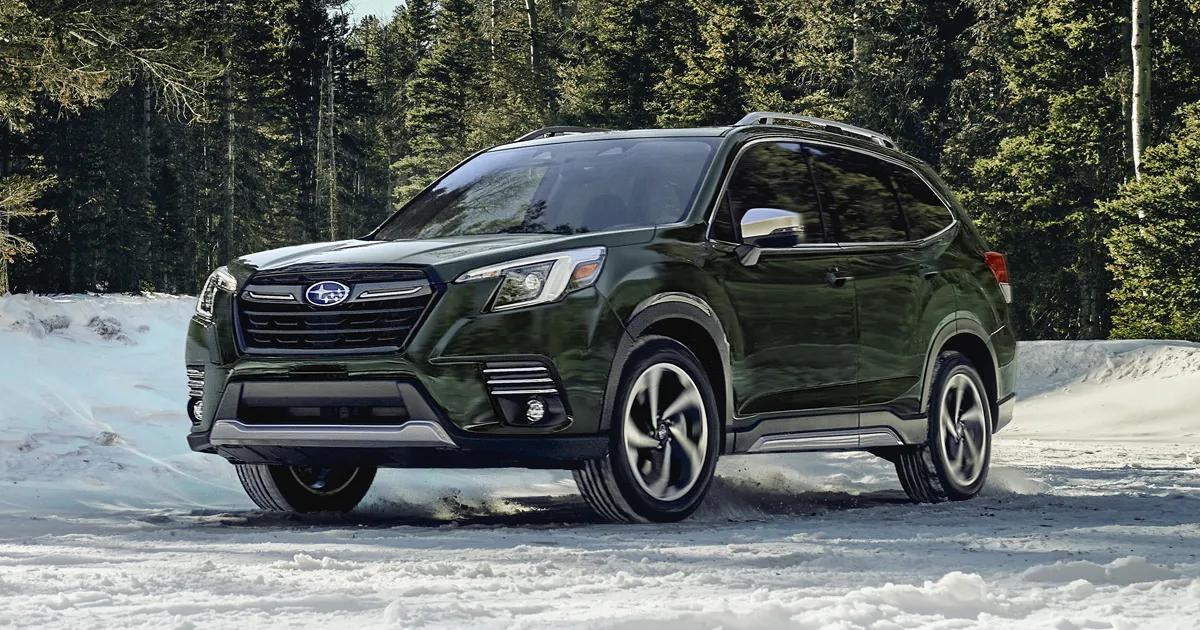2023 Subaru Forester Brake-Fluid and Trailer Towing User Guide
This page covers 2023 Subaru Forester essentials, including brake-fluid maintenance and trailer hauling. Learn how to tow your Forester safely and effectively.
2023 Subaru Forester Specs, Price, Features, Mileage (Brochure)
Brake fluid
Checking the fluid level
- Never let brake fluid contact your eyes because brake fluid can be harmful to your eyes. If brake fluid gets in your eyes, immediately flush them thoroughly with clean water. For safety, when performing this work, wearing eye protection is advisable.
- Brake fluid absorbs moisture from the air. Any absorbed moisture can cause a dangerous loss of braking performance.
- If the vehicle requires frequent refilling, there may be a leak. If you suspect a problem, have the vehicle checked at your SUBARU dealer.
CAUTION
- When adding brake fluid, be careful not to allow any dirt into the reservoir.
- Never splash the brake fluid over painted surfaces or rubber parts.
Alcohol contained in the brake fluid may damage them. - Be careful not to spill brake fluid when adding it. If brake fluid touches the exhaust pipe, it may cause a bad smell, smoke, and/or a fire. If brake fluid gets on the exhaust pipe, be sure to wipe it off.
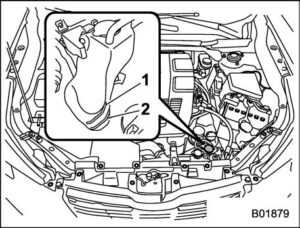 “MAX” level line
“MAX” level line- “MIN” level line
Check the fluid level monthly. Check the fluid level on the outside of the reservoir. Be sure to check the fluid level for the brake system at the shaded area in the illustration. If the fluid level is below “MIN”, add the recommended brake fluid to “MAX”. Use only brake fluid from a sealed container.
CAUTION
Never use different brands of brake fluid together. Also, avoid mixing DOT 3 and DOT 4 brake fluids even if they are the same brand.
Brake pedal
Check the brake pedal free play and reserve distance according to the maintenance schedule in the “Warranty and Maintenance Booklet”.
Replacement of brake pad
The disc brakes have audible wear indicators on the brake pads. If the brake pads wear close to their service limit, the wear indicator makes a very audible scraping noise when the brake pedal is applied. If you hear this scraping noise each time you apply the brake pedal, have the brake pads serviced by your SUBARU dealer as soon as possible.
CAUTION
If you continue to drive despite the scraping noise from the audible brake pad wear indicator, it will result in the need for costly brake rotor repair or replacement.
Breaking-in of new brake pads
When replacing the brake pad, use only genuine SUBARU parts. After replacement, the new parts must be broken in. Contact your SUBARU dealer for details.
Trailer towing
Towing
If towing is necessary, it is best done by your SUBARU dealer or a commercial towing service. Observe the following procedures for safety.

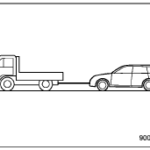
CAUTION
Keep metallic objects, magnetic sources, and signal transmitters away from the area between the access key fob and the push-button ignition switch. They may interfere with the communication between the access key fob and the pushbutton ignition switch. The following functions may be inoperable because of strong radio signals in the surrounding area or a low battery condition of the access key fob.
- Locking/unlocking doors (including the rear gate)
- Switching power status
- Starting engine
In such cases, perform the following procedure. When the battery of the access key fob is discharged, replace it with a new one.
Locking and unlocking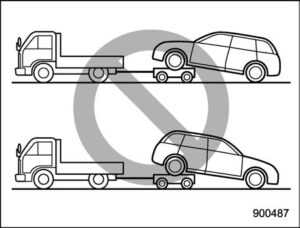
WARNING
Never tow AWD models with the front wheels raised off the ground while the rear wheels are on the ground, or with the rear wheels raised off the ground while the front wheels are on the ground. This will cause the vehicle to spin away due to the operation or deterioration of the center differential.
Towing hooks and tie-down hooks/holes
The towing hooks should be used only in an emergency.
CAUTION
Use only the specified towing hooks and tie-down hooks/holes. Never use suspension parts or other parts of the body for towing or tie-down purposes.
Front towing hook
- Take the towing hook, screwdriver and jack handle out of the cargo area.

- Cover the tip of a flat-head screwdriver with vinyl tape or cloth so that it will not scratch the bumper. Insert the flat-head screwdriver into the cutout of the cover and pry open the cover.

- Screw the towing hook into the thread hole until its thread can no longer be seen.
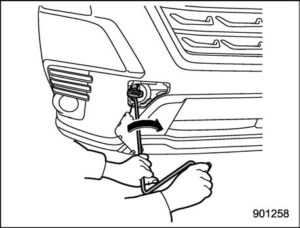
- Tighten the towing hook securely using the jack handle. After towing, remove the towing hook from the vehicle and stow it in the tool bucket. Fit the towing hook cover on the bumper.
WARNING
- Do not use the towing hook except when towing your vehicle.
- Be sure to remove the towing hook after towing. Leaving the towing hook mounted on the vehicle could interfere with the proper operation of the SRS airbag system in a frontal collision.
CAUTION
To prevent deformation to the bumper and the towing hook, do not apply an excessive load to the towing hook.
Rear towing hook
- Take the towing hook and screwdriver out of the tool bucket. Take the jack handle out of the cargo area.

- Cover the tip of a flat-head screwdriver with vinyl tape or cloth so that it will not scratch the bumper. Pry off the cover on the rear bumper using a screwdriver, and you will find a threaded hole for attaching the towing hook.
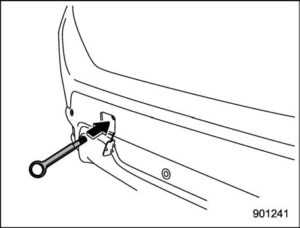
- Screw the towing hook into the thread hole until its thread can no longer be seen.

- Tighten the towing hook securely using the jack handle.
After towing, remove the towing hook from the vehicle and stow it in the tool bucket. Fit the towing hook cover on the bumper.
WARNING
- Do not use the towing hook except when towing your vehicle.
- Be sure to remove the towing hook after towing. Leaving the towing hook mounted on the vehicle could interfere with the proper operation of the fuel pump shut-off function when the vehicle is struck from behind.
CAUTION
To prevent deformation to the bumper and the towing hook, do not apply an excessive load to the towing hook.
Front tie-down hooks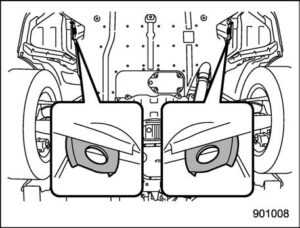
The front tie-down hooks are located between each of the front tires and the front bumper.
Rear tie-down holes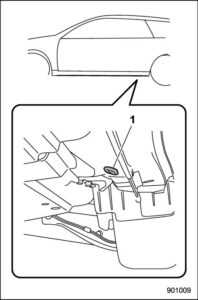
Rear tie-down hole
The rear tie-down holes are located near each of the jack-up reinforcements. There is a plug in each rear tie-down hole. To use the rear tie-down holes, remove the plugs. After using the rear tie-down holes, return the plugs to their original places.
WARNING
Use the rear tie-down holes only for downward anchoring. If they are used to anchor the vehicle in any other direction, cables may slip out of the holes, possibly causing a dangerous situation.
Using a flat-bed truck
This is the best way to transport your vehicle. Use the following procedures to ensure safe transportation.
- Shift the select lever into the “P” position.
- Apply the parking brake firmly.
- Secure the vehicle onto the carrier properly with safety chains. Each safety chain should be equally tightened and care must be taken not to pull the chains so tightly that the suspension bottoms out.
CAUTION
- If your vehicle has a bumper under guard (optional), be careful not to scrape it when placing the vehicle on the carrier and when removing the vehicle from the carrier.
- Transport by flatbed truck may cause the headlights to become misaligned. In such a case, have the headlight alignment checked by a SUBARU dealer after transporting the vehicle by a flatbed truck?
Towing with all wheels on the ground
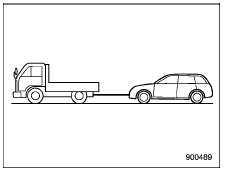
- Release the parking brake and put the transmission in the neutral position.
- The ignition switch should be in the “ON” position while the vehicle is being towed.
- Take up slack in the towline slowly to prevent damage to the vehicle.
WARNING
- Never turn the ignition switch to the “LOCK”/“OFF” position while the vehicle is being towed because the steering wheel and the direction of the wheels will be locked.
- Remember that the brake booster and power steering do not function when the engine is not running. Because the engine is turned off, it will take greater effort to operate the brake pedal and steering wheel.
CAUTION
- If transmission failure occurs, transport your vehicle on a flatbed truck.
- Sometimes damaged vehicles cannot be towed because of their damaged condition. In that case, use a flatbed truck for transportation.
- The traveling speed must be limited to less than 20 mph (32 km/h) and the traveling distance to less than 31 miles (50 km). For greater speeds and distances, transport your vehicle on a flatbed truck.
- Use a flatbed truck if there are long-distance downgrades or steep slopes. However, do not apply the brake pedal for a long time because the engine braking will not work while towing. Doing so could overheat the brake.
- Drive carefully and do not make an impact on the towing rope by suddenly starting.
- Use a specific towing rope for towing. If wire ropes and metal chains are needed to be used for towing, wrap the contact portion of the bumper with cloth to protect it from damage.
Access key fob – if the access key fob does not operate properly
CAUTION
Keep metallic objects, magnetic sources, and signal transmitters away from the area between the access key fob and the push-button ignition switch. They may interfere with the communication between the access key fob and the push-button ignition switch. The following functions may be inoperable because of strong radio signals in the surrounding area or a low battery condition of the access key fob.
- Locking/unlocking doors (including the rear gate)
- Switching power status
- Starting engine
In such cases, perform the following procedure. When the battery of the access key fob is discharged, replace it with a new one.
Locking and unlocking
- Release button
- Emergency key
While pressing the release button of the access key fob, take out the emergency key. Lock or unlock the driver’s door with the emergency key in the procedure described in “Locking and unlocking from the outside”
NOTE
After locking or unlocking, be sure to attach the emergency key back to the access key fob.
Switching power status
- Apply the parking brake.
- Shift the select lever to the “P” (Park) position.
- Depress the brake pedal.
- Hold the access key fob with the buttons facing you, and touch the push-button ignition switch with it. When the communication between the access key fob and the vehicle is completed, a chime (ding) will sound. At the same time, the status of the push-button ignition switch changes to either of the following.
- When the keyless access with the pushbutton start system is deactivated: “ACC”
- Under other conditions: “ON”
- When the keyless access with the push-button start system is deactivated, press the push-button ignition switch with the brake pedal released. The status of the push-button ignition switch then changes to “ON”.
NOTE
If the power does not switch even though the above procedure was followed precisely, contact your SUBARU dealer.

& Starting engine
- Apply the parking brake.
- Shift the select lever to the “P” (Park) position.
- Depress the brake pedal.

- Hold the access key fob with the buttons facing you, and touch the push-button ignition switch with it. When the communication between the access key fob and the vehicle is completed, a chime (ding) will sound. At the same time, the push-button ignition switch turns to the “ACC” or “ON” position.
- After the push-button ignition switch turns to the “ACC” or “ON” position, while depressing the brake pedal, press the push-button ignition switch.
NOTE
If the engine does not start even though the above procedure was followed precisely, contact your SUBARU dealer.
Rear gate – if the rear gate cannot be opened
In the event that you cannot open the rear gate by operating the rear gate opener button, you can open it from inside the cargo area.
- Remove the access cover at the bottom center of the rear gate trim using a flat-head screwdriver wrapped with vinyl tape or cloth.
- Locate the rear gate open lever behind the rear gate trim.
CAUTION
Never operate the rear gate open lever with your fingers because doing so may cause an injury. Always use a flat-head screwdriver or a similar tool.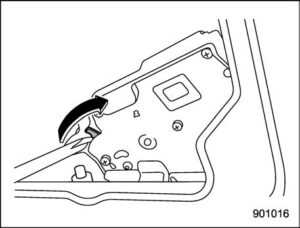 Models without power rear gate
Models without power rear gate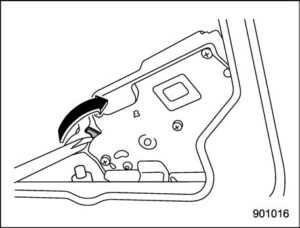 Models with power rear gate
Models with power rear gate - To open the rear gate, turn the lever to the right position.
Moonroof (if equipped) – if the moonroof does not close
If the moonroof does not close, we recommend that you have the system checked by a SUBARU dealer.
If your vehicle is involved in an accident
If your vehicle is involved in an accident, be sure to inspect the ground under the vehicle before restarting the engine. If you find that fuel has leaked on the ground, do not try to restart the engine. The fuel system has been damaged and is in need of repair. Immediately contact the nearest automotive service facility. We recommend that you consult your SUBARU dealer. Your vehicle has a fuel pump shut-off system. When the vehicle sustains an impact in an accident, etc., the fuel pump shut-off system stops supplying the fuel in order to minimize fuel leakage. However, depending on the impact conditions at the time of collision, the fuel pump shut-off system may not operate.
Perform the following procedures to restart the engine after the system is activated.
Models without “keyless access with push-button start system”:
- Turn the ignition switch to the “LOCK” or “ACC” position.
- Restart the engine.
Models with “keyless access with push-button start system”:
- Turn the push-button ignition switch to the “ACC” or “OFF” position.
- Restart the engine.
Automatic door locking/unlocking operation when involved in an accident
When the automatic door locking/unlocking function is ON, all the doors will be locked automatically while driving. When the vehicle sustains a strong impact which may trigger the airbags to deploy, the door locks may be unlocked automatically to enable emergency escape. Generally, an impact sustained from a rear-end collision does not trigger the airbags to deploy. However, if the impact is strong enough to deploy the airbags, it can also trigger the unlocking function. Under such circumstances, the automatic door unlocking function will be suspended and the doors will remain unlocked. Confirm the safety of the surroundings first and carry out the following to retrieve the automatic door locking/unlocking function.
Models without “keyless access with push-button start system”:
- Turn the ignition switch to the “LOCK” position.
- Turn the ignition switch to the “ON” position.
- Models with “keyless access with push-button start system”:
- Turn the push-button ignition switch to the “OFF” position.
- Turn the push-button ignition switch to the “ON” position.
NOTE
Depending on the severity of the impact, emergency unlocking may not function.
CAUTION
If the following occurs, there may be a malfunction in the system.
Have the system inspected by a SUBARU dealer.
- The doors unlock automatically while driving.
- With all doors shut, the doors unlock when pressing the lock side of the power door locking switch.
- The automatic door locking/unlocking function does not operate.
FAQ’s
The towing capacity of the Forester typically ranges from 1,500 to 3,000 pounds, depending on the engine and configuration.
The Forester can tow various types of trailers, including small campers, utility trailers, and boats.
You may need additional equipment, such as a trailer wiring harness and trailer brake controller, depending on the trailer and its electrical requirements.
Subaru may offer a trailer sway control system as part of its towing package to help stabilize the trailer while towing.
Depending on the trailer’s weight and the Forester’s configuration, you may need a weight distribution hitch to ensure safe and balanced towing.
Useful Links
View Full User Guide: Subaru Forester 2023 Base User Guide
2023 Subaru Forester Cleaning the Interior Base User Guide
2023 Subaro Forester Specs, Price, Features, Mileage (Brochure)

